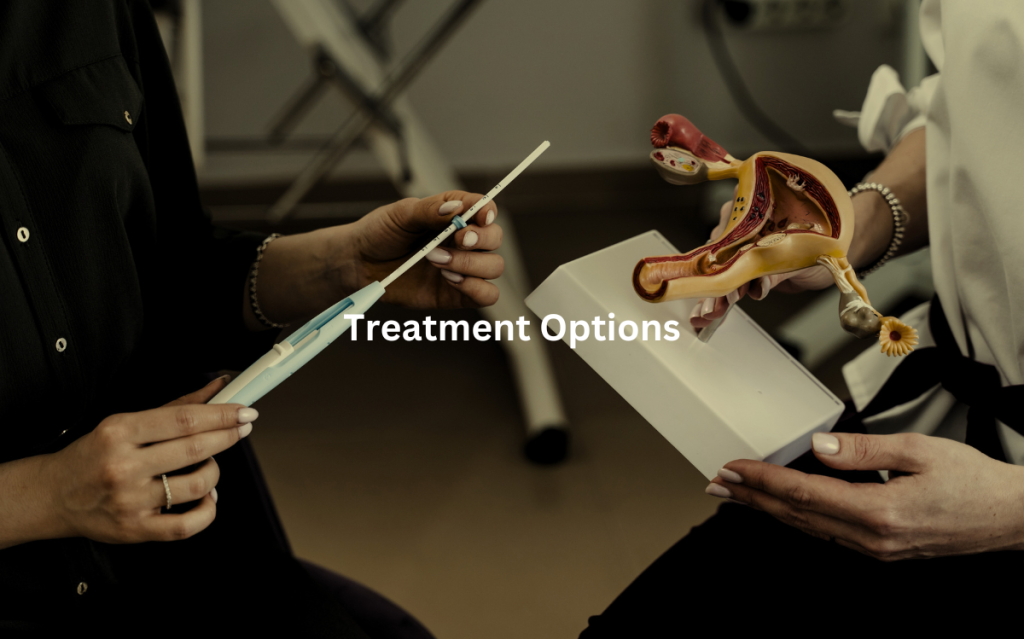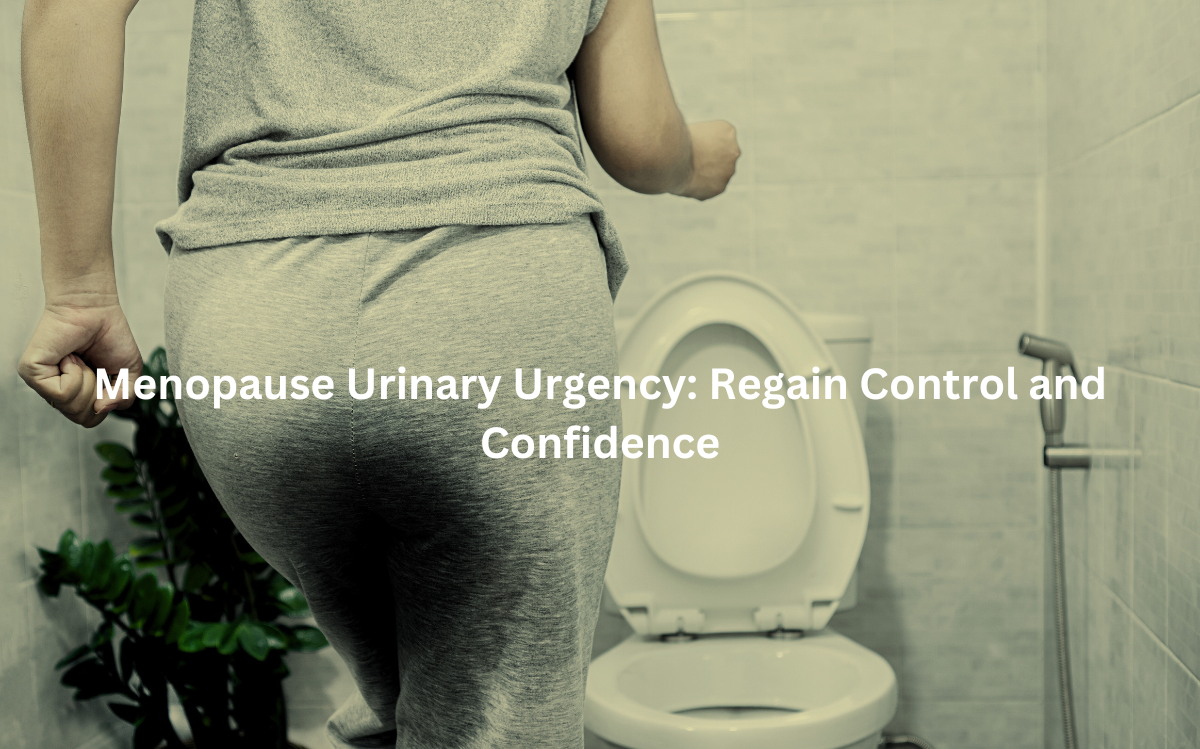Practical solutions for managing menopause urinary urgency, improving bladder control, and enhancing quality of life.
Menopause often brings unwelcome urinary symptoms like urgency, incontinence, and frequent infections. These issues stem from hormonal changes affecting bladder health. (1)
Fortunately, targeted treatments, lifestyle adjustments, and medical advice can help you regain control and improve daily life.
Key Takeaways
- Strengthening pelvic floor muscles significantly improves bladder control and reduces urgency.
- Vaginal oestrogen is an effective treatment for managing urogenital symptoms linked to menopause.
- Healthy habits like avoiding bladder irritants and regular check-ups maintain urinary health during menopause.
Menopause and Urinary Symptoms
Menopause sneaks in quietly, often disguised by hot flashes or restless nights, but for many women, its real mischief lies in the bladder. Imagine rushing to the bathroom only to find it’s a race you sometimes lose. That sudden, urgent need to go—or worse, leaks before you get there—isn’t just an annoyance. It’s a sign of how much oestrogen shapes a woman’s body.
Oestrogen (a hormone that’s like the glue holding things together) keeps the pelvic floor strong and elastic. Without it, things go downhill fast: urinary urgency, stress incontinence (leaking while sneezing, laughing, or jumping), and even dryness that makes everything worse.
It’s not just about bladder control, though. The problem goes deeper, often into the tissues themselves. And no, it’s not just “part of getting older”—it’s a chain reaction set off by dropping oestrogen levels.
Underlying Causes
The story begins with oestrogen—or the lack of it. As menopause takes hold, a condition called urogenital atrophy sets in. (2) It’s as bad as it sounds. The once-strong bladder lining thins, muscles lose tone, and everything weakens. (Think of a rubber band stretched too many times—it’s still there, but it doesn’t work like it used to.)
There’s more. Oestrogen keeps the vaginal pH balanced, a quiet but critical job. Without it, harmful bacteria flourish, opening the door for urinary tract infections (UTIs). These infections often come in waves—just when you think you’re in the clear, another one shows up.
Let’s break it down:
- Thinner bladder lining – Leads to irritation and increased urgency.
- Weaker pelvic floor muscles – Result in stress incontinence during physical activities.
- Overactive bladder – Triggers frequent trips to the toilet, sometimes for no real reason.
- Higher UTI risk – Disrupts everyday life with painful, recurring infections.
Oestrogen doesn’t just step back—it leaves chaos behind. That’s why the bladder feels like it’s gone rogue.
Impact on Daily Life
Bladder trouble doesn’t come with a warning sign. But for women navigating menopause, it can quietly reshape their entire day. Nighttime trips to the bathroom can fracture precious hours of sleep, leaving mornings hazy and groggy.
Imagine starting the day already drained. At work, the distraction of frequent bathroom runs can chip away at focus—and confidence. Some women carry an extra change of clothes in their bag, just in case. It’s not just physical inconvenience; it’s the constant fear of being caught off guard.
Social outings become tricky. A simple coffee date or a walk in the park feels daunting when you’re scouting for the nearest toilet.
Over time, that worry seeps into emotional health. Anxiety over bladder control can snowball into isolation or even depression. Many describe it as a silent thief—stealing ease, joy, and spontaneity from everyday life.
Lifestyle Adjustments for Symptom Relief
Managing these symptoms doesn’t mean overhauling your life. Small, deliberate changes can lighten the load and restore a sense of control.
- Pelvic Floor Exercises: Think of Kegels as a workout for the bladder’s support system. Done daily (start with 10 reps three times a day), they gradually build muscle strength, helping control leaks.
- Dietary Tweaks: Foods like coffee, soda, spicy curries, and even chocolate might irritate the bladder. Cutting back can help, but hydration matters too. Aim for six to eight glasses of water a day—dehydration can irritate the bladder too.
- Weight Management: Carrying even five extra kilograms adds pressure to the bladder, intensifying symptoms. Losing just a little weight can ease that strain.
- Physical Activity: Gentle exercises, like walking or yoga, improve circulation and support pelvic health. Plus, movement boosts mood—an added bonus.
These steps are small but meaningful. And if symptoms linger or feel overwhelming, consulting a doctor might uncover other solutions, from medications to physical therapy.
Treatment Options

Sometimes, no matter how hard you try, lifestyle changes aren’t enough to tame menopause-related urinary symptoms. That’s when targeted treatments step in to offer relief.
- Vaginal Oestrogen Therapies
Products like Vagifem and Ovestin (readily available in Australia) provide a low-dose oestrogen fix delivered straight to the source. These therapies improve the health of vaginal tissues and, by extension, ease urinary symptoms. Unlike systemic hormone replacement therapy (HRT), vaginal oestrogen is localised, so the risk of side effects is much lower. Women often notice less dryness, fewer bladder infections, and improved control within weeks of starting treatment. - Medications for Overactive Bladder
For women dealing with frequent or sudden urges, anticholinergics and beta-3 agonists might help. These drugs work by relaxing bladder muscles, calming overactivity. It’s not an instant fix; you might need several weeks to see full results. But many women report fewer accidents and better sleep. - Non-Hormonal Alternatives
Some women can’t—or won’t—use oestrogen. For them, non-hormonal options, such as vaginal moisturisers and lubricants, can ease discomfort. Herbal remedies, like cranberry extract or soy isoflavones, are sometimes suggested, but evidence on their effectiveness is mixed. It’s always worth asking your doctor about safe, evidence-backed alternatives.
Preventive Strategies
Preventing urinary symptoms isn’t foolproof, but simple habits can go a long way. A stitch in time, as they say, saves nine.
- Pelvic Floor Strengthening
Doing Kegels before menopause? Genius move. It’s like setting up a safety net for your bladder. Strengthening the pelvic floor helps avoid leaks later, and it’s free. Start with 10 squeezes, holding each for 5 seconds, three times daily. - Hydration Balance
Too much water strains the bladder; too little irritates it. Finding the sweet spot—around 1.5 to 2 litres daily—is key. Swap fizzy drinks for plain water, and your bladder might thank you. - Avoid Irritants
Common culprits like caffeine, alcohol, and spicy foods can aggravate symptoms. Cut back slowly to see what helps. You might not need to give up coffee entirely, but moderation often works wonders. - Regular Check-Ups
Here’s the deal: Don’t wait until symptoms are unbearable. Check in with your GP or gynaecologist regularly, especially if you notice changes. Early intervention keeps minor issues from spiraling.
With consistency, these steps can help women stay ahead of troublesome symptoms—because prevention beats treatment every time.
When to Seek Medical Advice
There’s a point where trying to tough it out just doesn’t work anymore. The signs might creep in slowly, or maybe they hit like a thunderclap—but either way, knowing when to call the doctor can make all the difference.
Some bladder issues resolve with time and care, but persistent or severe symptoms are another story. If you’ve tried lifestyle changes and home remedies (cutting back caffeine, doing Kegels, staying hydrated) and still feel stuck, it’s time to consider professional help.
Here’s when to book that appointment:
- Persistent Symptoms: If bladder urgency, frequency, or leakage stick around or worsen, it could signal an overactive bladder or something more serious, like interstitial cystitis.
- Frequent UTIs: Getting more than 2–3 urinary tract infections in a year? That’s a red flag. Painful urination, cloudy urine, or even fever might mean infection—or something more complex.
- Impact on Quality of Life: Symptoms interfering with work, sleep, or relationships? Don’t let it go. Anxiety and embarrassment can snowball into bigger emotional and mental health issues.
A doctor might run tests (like a urinalysis or bladder scan) to rule out conditions like diabetes, kidney stones, or even pelvic organ prolapse. Depending on findings, they might suggest medications, physical therapy, or a referral to a specialist, such as a urologist or urogynecologist.
Don’t wait until you’re desperate. Early intervention means more treatment options—and a better shot at reclaiming your daily life.
Conclusion
Start small. A few minutes of pelvic floor exercises each day, cutting back on coffee, or trying a new treatment could make a world of difference. If symptoms persist, don’t hesitate to seek help—there’s no reason to suffer in silence. Managing menopause isn’t about perfection; it’s about progress, one step at a time.
Don’t let menopause hold you back—book your personalised consultation with Modern Menopause today and take control of your health.
FAQ
What are the common symptoms of urinary urgency during menopause?
During menopause, many women experience symptoms like urinary frequency, urge incontinence, and painful urination. These symptoms stem from hormonal changes, particularly the lack of estrogen, which affects the pelvic area and bladder muscles.
Vaginal atrophy can worsen these urinary problems, leading to leakage or frequent trips to pass urine. If you’re dealing with symptoms of menopause, a menopause specialist can help restore balance and guide you through managing these changes effectively.
How does hormone therapy affect urinary urgency in menopause?
Hormone therapy, including systemic HRT and vaginal oestrogen, is effective in alleviating urinary urgency. As estrogen levels drop during menopause, the pelvic floor muscles weaken, contributing to bladder symptoms like frequent urination and urge incontinence. Vaginal oestrogen directly targets vaginal atrophy and improves bladder and urethra health.
If you’re experiencing urinary incontinence or other bladder symptoms, hormone replacement therapy may help restore control and ease discomfort, but it’s important to discuss risks, such as potential breast cancer concerns, with a healthcare professional.
What risk factors contribute to urinary urgency during menopause?
Several factors increase the likelihood of developing urinary urgency during menopause. Extra pressure on the bladder, caused by factors like obesity, can exacerbate symptoms like incontinence and frequent urination. Women with weakened pelvic floor muscles or a history of bladder symptoms are more likely to experience these issues.
Postmenopausal women often face symptoms of vaginal atrophy, which can impact bladder function. Maintaining a healthy weight, practicing pelvic floor exercises, and managing stress are all key to mitigating these risk factors.
Can bladder training help manage urinary urgency during menopause?
Yes, bladder training can be a helpful technique for managing urinary urgency during menopause. By scheduling regular bathroom visits and gradually increasing the time between them, you can help your bladder regain control. Pelvic floor exercises also strengthen the muscles supporting the bladder, improving symptoms like urine leakage.
If you’re experiencing bladder problems, working with a healthcare professional or menopause specialist to create a tailored bladder training plan can significantly reduce urinary incontinence and improve your quality of life.
When should I book an appointment with a menopause specialist for urinary urgency?
If you’re frequently passing urine, experiencing leaks, or dealing with painful urination, it may be time to book an appointment with a menopause specialist. These symptoms are often linked to menopause and may worsen without proper treatment.
A menopause specialist can assess your bladder health, suggest treatments like vaginal estrogen or hormone replacement therapy, and recommend lifestyle changes. If you’re experiencing incontinence symptoms or other bladder issues, early intervention can help restore comfort and improve your overall well-being.
References
- https://pmc.ncbi.nlm.nih.gov/articles/PMC4876519/
- https://pubmed.ncbi.nlm.nih.gov/20156082/#:~:text=Abstract,reduction%20in%20quality%20of%20life.

Leave a Reply